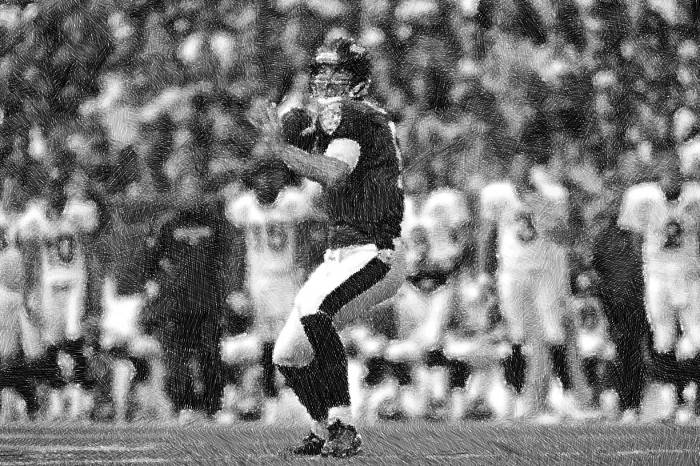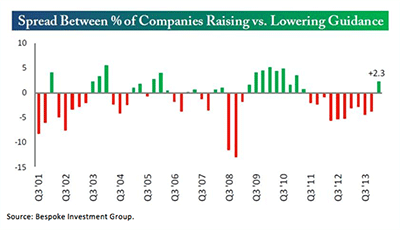“Throw Deep?!”
by Jeffrey Saut, Chief Investment Strategist, Raymond James
April 28, 2014
Back in the late 1980s a newspaperman visiting the Raiders football training camp in California had just returned from the Jack London Historic Monument. He read a sample of London’s prose to the Raiders’ colorful quarterback, Ken “The Snake” Stabler:
“I would rather be ashes than dust! I would rather that my spark should burn out in a brilliant blaze than it should be stifled by rot! I would rather be a superb meteor, every atom of me in magnificent glow, than a sleepy and permanent planet. The proper function of a man is to live, not to exist. I shall not waste my days in trying to prolong them. I shall use my time.”
The newspaperman asked the quarterback, “What does this mean to you?” “Throw deep,” said Stabler!
Throwing Deep, the Long Bomb, the Hail Mary, are all phrases usually associated with football. It is the spectacular play with the possibility of a quick score, as opposed to the Woody Hayes three-yards-and-a-cloud-of-dust “grind it out” strategy. I was reminded of this Stabler story last Friday because it was the Flora-Bama Mullet Toss at Perdido Key here in Florida. The annual Mullet Toss is a fish-throwing festival that always takes place at the Flora-Bama Lounge & Package Store, a bar often frequented by the Alabama-based Kenny Stabler. The Flora-Bama is a beachside bar, and a Gulf Coast cultural landmark, often touted as being America’s “Last Great Roadhouse.” It takes its name from its location on the Florida-Alabama border with the bar being Florida-centric, but with its western wall within six feet of the Alabama state line. The bar was lionized by Jimmy Buffet in the song “Bama Breeze” (http://www.youtube.com/watch?v=vfhNKK7rkhw).
Coming into this year the “Throwing Deep” attitude was pretty pervasive on the Street of Dreams, spurred by the S&P 500’s (SPX/1863.40) ~32% gain in 2013. Our strategy, however, was not so bold. As often stated, the history of 40%+ rallies, like the one we have experienced since June 2012 without so much as a 10% pullback, is to see a 5% - 7% drawdown in the first three months of the new year, and a 10% - 12% correction sometime during the year. Well, we got a 6.2% pullback from mid-January into the February 5th low on an intraday basis. From there the SPX re-rallied to a new all-time intraday high of 1897.28 on April 4th. On the same day the SPX was making an all-time high, it also closed below the previous session’s intraday low, which constitutes what a technical analyst would deem an outside downside reversal day (read: bearish). I wrote about this in the following day’s Morning Tack and stated, “It is unknowable, as of yet, if this is the start of a 10% - 12% correction.” Subsequently, the SPX broke below its 1835 – 1840 support zone and fell into its recent low of 1814.36, but the next day we experienced another reversal except this time it was to the upside. I also wrote about that reversal in the April 16th edition of the Morning Tack. Since then the SPX has tried twice to better its all-time closing high of 1890.90 (4/2/14), as well as its all-time intraday high of 1897.28, but has failed to do so. And, then there was Friday.
Early morning weakness in the pre-opening futures last Friday was driven by news that Ukraine’s government had threatened to blockade the pro-Russian militants in the city of Slovyansk. Our equity markets attempted to deal with that news and stabilized around 11:00 a.m. That stabilization led to a rally attempt into the lunch hour, but then a Ukrainian deputy-minister said there was the danger of a Russian invasion over the weekend, leaving the SPX near the lows of the session. For the week, the SPX flat-lined by losing a mere 0.08% and resting marginally above its 50-day moving average at 1858.35. In fact, the SPX has been in a flat-line pattern for almost two months, having only gained 0.03% since March 7th, causing many Wall Street wags to proclaim a major “top” is at hand. However, as Lowry’s writes:
The 88 year history of the Lowry Analysis shows that such stalemates are relatively common developments during most bull markets. They simply reflect periods in which investor buying enthusiasm is temporarily fatigued, at the same time that sellers are reluctant to part with their stocks, in anticipation of eventually higher prices. Thus, there is not enough Demand to push prices up to new bull market highs, and there is not a strong enough desire to sell to drive prices sharply lower. Eventually, sideways trading patterns are usually resolved through the process of a short term correction, in which investors become impatient and sell, pushing prices low enough to revitalize buying enthusiasm and launch the next leg of the bull market. Some signs of a developing short term correction have already been emerging in recent days. As a result, it may be worthwhile for investors to hold back on new buying temporarily, until our short term indicators drop back to oversold levels again.
Obviously I agree with the astute Lowry’s organization and I will say it again, “It is too early to know if this is the beginning of a 10% - 12% correction.”
Turning to earnings season, as of Friday more than 700 companies had reported earnings with 61.1% of those companies beating estimates, while only 55.2% bettered revenue estimates. A lot of the earnings beat has come from just a few companies. For example, by beating expectations, Apple (AAPL/$571.94/Outperform) alone accounted for 4.2% of what the SPX is expected to earn for the quarter. What’s interesting about this earning’s season is that for the first time in 10 quarters companies are raising guidance (see chart on page 3). Overall, forecasts for the quarter call for earnings growth of 8.1%. While one quarter does not a year make, if that 8.1% growth rate proves correct, it implies a much higher P/E multiple for the SPX based on Benjamin Graham’s P/E formula. Said formula is P/E = 8.5 + 2(G) where G is the earnings growth rate. Graham observed that the average no-growth stock sold at 8.5 times earnings and that price-earnings ratios increase by twice the rate of earnings growth. Ergo, 8.5 + 2(8.1) renders an estimated P/E ratio of 24.7x. Now I seriously doubt the SPX will trade at 24.7 times this year’s consensus EPS estimate of $120, but if it did the SPX would be at 2964. A more plausible P/E multiple is suggested by “The Rule of 20,” which postulates a fair P/E multiple is 20 minus the inflation rate. The current inflation rate is somewhere near 2% (by my pencil); so 20 minus 2% foots to an 18 P/E multiple for the SPX. Thus, 18 x $120 equals 2160 for a much more realistic price target.
The call for this week: After six consecutive up sessions that winning skein for SPX ended last Tuesday. Once again, it was the usual suspects getting slammed that we saw a few weeks ago (high growth/P/E multiple names). Interestingly, that selling has left the Consumer Discretionary and Technology sectors oversold by my work. Some names from Raymond James’ research universe that play to the technology sector for your consideration, and have recently beaten earnings/revenue estimates and raised forward earnings guidance, include: Strong Buy-rated Altera (ALTR/$33.09) and Skyworks Solutions (SWKS/$41.46), as well as Outperform-rated F5 Networks (FFIV/$103.52), Manhattan Associates (MANH/$31.77), and Advanced Micro Devices (AMD/$4.05). This morning the futures are higher (+6 points) on no Russian Rout over the weekend and more Merger Monday action given the Pfizer news. As long as the 1850 – 1860 level, basis the SPX, holds, the upside should continue to be favored.















